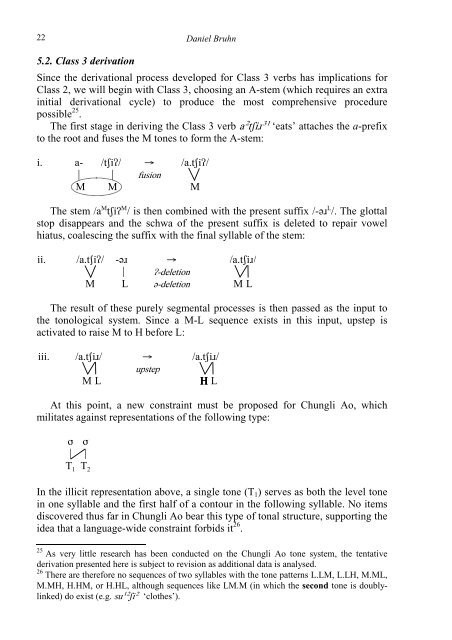A TONAL TAXONOMY OF CHUNGLI AO VERBS Daniel Bruhn ...
A TONAL TAXONOMY OF CHUNGLI AO VERBS Daniel Bruhn ...
A TONAL TAXONOMY OF CHUNGLI AO VERBS Daniel Bruhn ...
Create successful ePaper yourself
Turn your PDF publications into a flip-book with our unique Google optimized e-Paper software.
22<br />
5.2. Class 3 derivation<br />
<strong>Daniel</strong> <strong>Bruhn</strong><br />
Since the derivational process developed for Class 3 verbs has implications for<br />
Class 2, we will begin with Class 3, choosing an A-stem (which requires an extra<br />
initial derivational cycle) to produce the most comprehensive procedure<br />
possible 25 .<br />
The first stage in deriving the Class 3 verb a²tʃiɹ³¹ ‘eats’ attaches the a-prefix<br />
to the root and fuses the M tones to form the A-stem:<br />
i. a- /tʃiʔ/ → /a.tʃiʔ/<br />
| | fusion<br />
M M M<br />
The stem /a M tʃiʔ M / is then combined with the present suffix /-əɹ L /. The glottal<br />
stop disappears and the schwa of the present suffix is deleted to repair vowel<br />
hiatus, coalescing the suffix with the final syllable of the stem:<br />
ii. /a.tʃiʔ/ -əɹ → /a.tʃiɹ/<br />
| ʔ-deletion<br />
M L ə-deletion M L<br />
The result of these purely segmental processes is then passed as the input to<br />
the tonological system. Since a M-L sequence exists in this input, upstep is<br />
activated to raise M to H before L:<br />
iii. /a.tʃiɹ/ → /a.tʃiɹ/<br />
upstep<br />
M L H L<br />
At this point, a new constraint must be proposed for Chungli Ao, which<br />
militates against representations of the following type:<br />
σ σ<br />
| |<br />
T 1 T 2<br />
In the illicit representation above, a single tone (T1) serves as both the level tone<br />
in one syllable and the first half of a contour in the following syllable. No items<br />
discovered thus far in Chungli Ao bear this type of tonal structure, supporting the<br />
idea that a language-wide constraint forbids it 26 .<br />
25 As very little research has been conducted on the Chungli Ao tone system, the tentative<br />
derivation presented here is subject to revision as additional data is analysed.<br />
26 There are therefore no sequences of two syllables with the tone patterns L.LM, L.LH, M.ML,<br />
M.MH, H.HM, or H.HL, although sequences like LM.M (in which the second tone is doublylinked)<br />
do exist (e.g. su¹²ʃi² ‘clothes’).

















